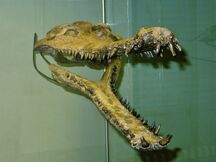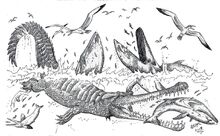
The Only known Specimen that represents the Genus.
Piscogavialis is an extinct species of gavialid crocodylian.
The only known species is the P. jugaliperforatus. The Fossils of Piscogavialis have been found from the Pisco Formation that belong to the Sacaco Basin, at Southern Peru; in 1998. It is the first species of reptile known from the formation, which is otherwise notable for its high diversity of fossil vertebrates. [1]
Description[]

An indicative hunting behaviore speculation that risen form the animal's coexistence with whale species; art done by the paleoartist hodarinundu
Piscogavialis is known only from a single specimen, so far, it represents some of the best-preserved gavialid known from South America. The skull is well preserved and is nearly complete. In association with the skull, a mandible and some postcranial material have also been found. Several important features of the skull support that belongs to the Gavialidae, which also includes species such as the gharials and the false gharials. The habitat in which the remains of Piscogavialis have been found suggests that it lived in a coastal environment. The presence of other species that belong to the gryposuchine, in coastal environments may be an indication that all members of the subfamily inhabited coastal regions. However, some gryposuchine species have been found from localities that clearly represent non-marine environments.[2]
Paleobiology[]
The strata from which remains of Piscogavialis have been found suggest that it lived in a coastal environment. Another extinct gavialid, Siquisiquesuchus, is also known to have lived in a coastal setting.
Sources[]
[1] - https://link.springer.com/article/10.1007%2FBF02988368
[2] - https://www.tandfonline.com/doi/abs/10.1017/S1477201906001829